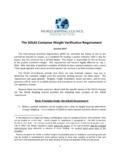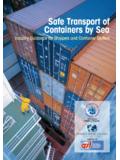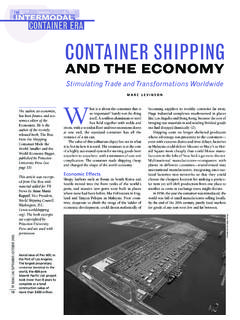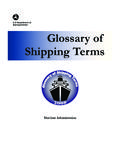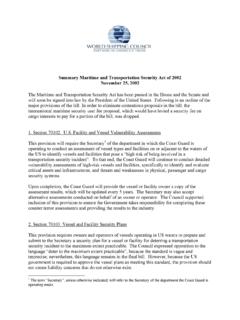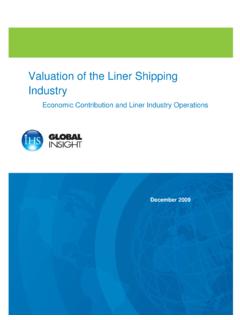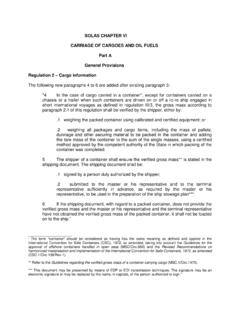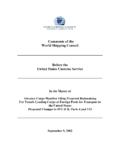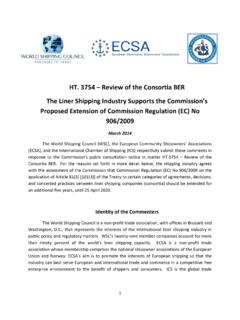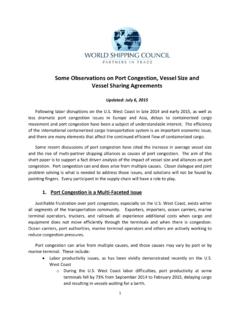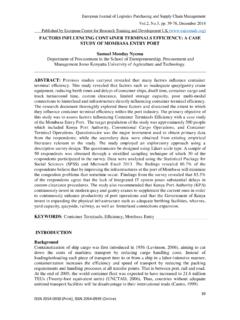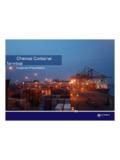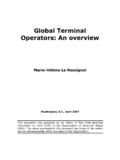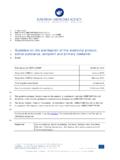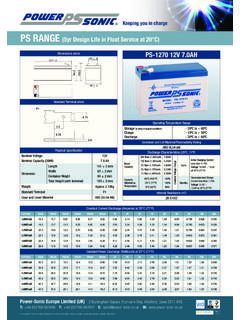Transcription of E SUB-COMMITTEE ON DANGEROUS GOODS, …
1 I:\DSC\17\ E SUB-COMMITTEE ON DANGEROUS GOODS, solid cargoes AND CONTAINERS 17th session Agenda item 7 DSC 17 27 July 2012 Original: ENGLISH DEVELOPMENT OF MEASURES TO PREVENT LOSS OF CONTAINERS Verification of container weights Submitted by Denmark, the Netherlands, the United States, BIMCO, the International Association of Ports and Harbors (IAPH), the International Chamber of Shipping (ICS), the International Transport Workers Federation (ITF) and the World Shipping Council (WSC) SUMMARY Executive summary: This document provides examples of incidents involving misdeclared container weights, as indicated in paragraph 19 of document DSC 17/7. Strategic direction: High-level action: Planned output: Action to be taken: Paragraph 4 Related documents: DSC 17/7; MSC 89/25, MSC 89/22/11, MSC 89/22/17; DSC 16/2/1, DSC 16/14 and DSC 16/15. Introduction 1 Document 17/7 notes that SOLAS has addressed the issue of container weights by imposing an obligation on the shipper to provide accurate container weights via regulation VI/2; however, it does not require a container to be weighed.
2 2 It is not uncommon for a shipper's declared weight to be incorrect, for the incorrect weight to be used by the ship and the port facility in the handling and stowage of the container , and for the incorrect weight to be the cause or a contributing cause to operational and safety incidents and accidents. 3 Annexed to this document are recent examples of incidents involving misdeclared container weights. Action requested of the SUB-COMMITTEE 4 The SUB-COMMITTEE is invited to note the information provided. ** DSC 17 Annex, page 1 I:\DSC\17\ ANNEX EXAMPLES OF INCIDENTS INVOLVING MISDECLARED container WEIGHTS Note on examples: The examples in this annex have been obtained from public sources. The incidents identified herein may have involved contributing causes separate from misdeclared container weights. This annex does not purport to provide a comprehensive summary of cases involving misdeclared container weights; rather, it is intended to provide illustrative examples of the significant safety issues that misdeclared container weights may give rise to on shore and on ships.
3 June 2011: Containership Deneb in Algeciras: The ship in this picture suffered a significant stability incident. A review after the incident found that out of the 168 containers on the load list, 16 or roughly 1 out 10 containers had actual weights far in excess of the declared weights. The actual weights exceeded the declared weight in a range from between times as much as the declared weight to as much as times the declared weight. The total, actual weight of these 16 containers was more than 278 tonnes above their total, declared weight of about 93 tonnes or four times higher than their declared weight. DSC 17 Annex, page 2 I:\DSC\17\ January 2007: MSC Napoli: "About 660 containers stowed on deck, which had remained dry, were also weighed. The weights of 137 (20%) of these containers were more than 3 tonnes different from their declared weights.
4 The largest difference was 20 tonnes, and the total weight of the 137 containers was 312 tonnes heavier than on the cargo manifest" (Source: "Report on the investigation of the structural failure of MSC Napoli", Marine Accident Investigation Branch, Report 9/208, April 2008, ). February 25, 2011: Longshore & Shipping News "Near miss" at Australia wharf as 28-tonne container falls "The container that fell 12 meters and narrowly missed two workers was severely overloaded and the third accident this month at Darwin Port. Two workers at the Darwin Port had to run to avoid a shipping container crashing onto East Arm Wharf at the weekend, the Maritime Union of Australia says. The container was listed as four tonnes, but the Maritime Union says it weighed 28 tonnes and exceeded the crane's load limit." May 9, 2011: ABC News Melbourne: An overloaded forklift lies in a container yard in west Melbourne after its load tipped it forward, May 9, 2011.
5 Story from May 10, 2011. DSC 17 Annex, page 3 I:\DSC\17\ February 2007: Containership MV Limari in Damietta: container stack collapsed due to stack overweight. The master's incident report to the authorities notes that: "Excessively heavy units loaded in the upper tiers and that the maximum stack weight had been exceeded considerably in some rows. The effect of the overweight units was to impose excessive forces on the lashings. Further, exceeding permissible weight distribution and/or exceeding the maximum stack weight in any stack, results in overstressed stowage/securing elements and overstressed containers". The actual container weights were established by the devices on the gantry crane when lifting and shifting the collapsed containers. The actual container weights exceeded the declared weights by 362% (Row 08), 393% (Row 06), 407% (Row 04) and 209% (Row 02) in Bay 52 where the collapse occurred.
6 DSC 17 Annex, page 4 I:\DSC\17\ March 2011: Excerpt from the publication " container carriage. A selection of articles previously published by Gard AS": "Two recent cases which Gard Services has been involved with have certain similarities. Both cases involved heavy weather and the collapse of an on-deck container stack in way of the bottom container . In each case, the bottom container was of questionable fitness in terms of structural integrity. However, that was not the only factor. In each case the weight of certain containers within the stack was found to be in excess of the manifested weight. In one case, four containers (forty foot units) in the collapsed stack were found to have 18 MT or more undeclared cargo, which even resulted in the maximum operating gross weight for each container being exceeded". (The Gard publication was accessed on December 6, 2011, at: ).
7 DSC 17 Annex, page 5 I:\DSC\17\ January 2006: P&O Nedlloyd Genoa: Misdeclared container weights contributed to this incident. "The declared weight of a container provided by the shipper and used for all stow planning and onboard stability purposes can, if inaccurate, cause major discrepancies between actual and declared weights. Furthermore, incorrect weight can result in stack overload and the application of excessive compression and racking forces on containers and their lashings. Although there are no financial gains to be made by the shipper who declares less than actual weight, the industry acknowledges that overweight containers are a problem. However, as yet this has not justified a requirement for compulsory weighing of containers prior to loading" (Source: "Report on the investigation of the loss of containers overboard from P&O Nedlloyd Genoa", Marine Accident Investigation Branch, Report 20/2006, August 2006, pages 19, 30 and 31) 2011: Mariners' Alerting and Reporting Scheme (MARS): Hazards of under-declared cargo weights: "A large container vessel was loading at the final load port before commencing a trans-ocean voyage.
8 The exit channel from the terminal had a draught restriction and sailing was subject to a narrow tidal window. Pre-arrival loading information listed some 350 containers, most of them going on the deck stacks. Being a regular vessel at the port, the terminal's computer system provided a departure stability condition with the sailing draughts allowing for adequate under-keel clearance (UKC) as per company's SMS. However, during the latter half of the 12-hour loading period, the chief officer realised that there was substantial under-declaration in the manifested container weights (later estimated to be an average of 12 per cent). This meant that after loading the manifested boxes, the ship was in serious danger of grounding in the channel. Thanks to quick thinking by the master, a total of about 850 tonnes of ballast was discharged before sailing from the twin auto-heeling tanks, which due to their high location and narrow width resulted in a safe even-keel trim and an acceptable stability condition.
9 The ballast was restored in the heeling tanks after reaching deep waters but unfortunately, it was realised after sailing that stack-weight limits had been exceeded in many deck stacks." (MARS 2011 was accessed on December 7, 2011, at: ). DSC 17 Annex, page 6 I:\DSC\17\ January 6, 2011: Beira: While lifting the container , the shore crane stopped and went downwards. Declared cargo gross weight was 25,000 kilograms. Actual gross weight was 46,000 kilograms. Quay crane was out of service for 3 days. June 28, 2010: Port of Longoni: While lifting the container , the stacker tilted over damaging the container beyond repair. Stacker operator was not seriously injured due to cabin safety belt. Declared cargo gross weight was 16,890 kilograms. Actual gross weight as established by the harbor weighing bridge after the incident was 30,220 kilograms.
10 _____
